Is Urban and Rural Construction Land Quota Trading “Chicken Ribs”? An Empirical Study on Chongqing, China
Abstract
:1. Introduction
2. Research Background
2.1. TDR in Land Administration
2.2. Market-Oriented Land Administration System in China
3. Theoretical Framework
3.1. Theoretical Analysis
3.2. Model Analysis and Research Hypothesis
4. Methodology
4.1. Research Approach
4.2. Estimation Method and Variable Selection
4.3. Data
5. Results
5.1. Synthesis Results
5.2. Placebo Test
5.2.1. Permutation Test
5.2.2. Transforming the Disposal Group
5.2.3. Transforming the Time
5.2.4. Testing Impacts of the Coupling Policy
6. Discussion
6.1. Findings
6.2. Limitations
6.3. Future Studies
7. Conclusions and Policy Suggestions
Author Contributions
Funding
Institutional Review Board Statement
Informed Consent Statement
Data Availability Statement
Conflicts of Interest
References
- Tan, R.; Qu, F. Spatial allocation efficiency of farmland conversion and farmland resource loss in China. China Soft Sci. 2006, 5, 49–57. [Google Scholar]
- Wang, H.; Wang, L.; Tao, R. Local experiments in transferrable land development rights in China: Backgrounds, models, challenges and breakthrough. City Plan. Rev. 2011, 35, 9–13. [Google Scholar]
- Shao, T.; Cui, F.; Fan, Y.; Xu, Q. Land use efficiency, regional disparities and the requisition-compensation balance among regions. China Econ. Q. 2011, 3, 1087–1104. [Google Scholar]
- Tan, R. Quantitative assessment on the impact of governmental intervention on land allocation efficiency in the processes of farmland acquisition and urban land conveyance. China Land Sci. 2010, 8, 21–26. [Google Scholar]
- Wang, Z.; Fang, C.; Wang, J. Observation and reflection on land policy of linking the increase in land used for urban construction with the decrease in land used for rural construction. China Popul. Resour. Environ. 2012, 1, 96–102. [Google Scholar]
- Michael, D.; Patricia, M.; Rick, P. Planners’ experiences in managing growth using transferable development rights (TDR) in the United States. Land Use Policy 2008, 25, 378–387. [Google Scholar]
- Linkous, E.; Laurian, L.; Neely, S. Why do counties adopt transfer of development rights programs? J. Environ. Plan. Manag. 2019, 62, 2352–2374. [Google Scholar] [CrossRef]
- Budd, C.; Thomas, N. Transfer of development rights: A new concept in land use management. Apprais. J. 1973, 3, 400–409. [Google Scholar]
- Linkous, E. Transfer of development rights in theory and practice: The restructuring of TDR to incentivize development. Land Use Policy 2016, 51, 162–171. [Google Scholar] [CrossRef]
- David, N.; Jennifer, O.; Kristen, C. Public policies for managing urban growth and protecting open space: Policy instruments and lessons learned in the United States. Landsc. Urban Plan. 2004, 2–3, 271–286. [Google Scholar]
- McConnell, V.; Kopits, E.; Walls, M. How Well can Markets for Development Rights Work? Evaluating A Farmland Preservation Program; Working Paper Series from RePEc; Federal Reserve Bank of St Louis: St. Louis, MO, USA, 2003. [Google Scholar]
- Wang, H.; He, C.; Li, W.; Nie, X. Will transferable development rights (TDR) increase regional economic imbalance? A quota transaction case of cultivated land conversion and reclamation in Guangxi, China. Habitat Int. 2020, 104, 102254. [Google Scholar] [CrossRef]
- Barrows, R.; Prenguber, B. Transfer of development rights: An analysis of a new land use policy tool. Am. J. Agric. Econ. 1975, 4, 549–557. [Google Scholar] [CrossRef]
- Linkous, E. Transfer of development rights and urban land markets. Environ. Plan. 2017, 5, 1122–1145. [Google Scholar] [CrossRef]
- Ferreira, A. Reconsidering the merit of market-oriented planning innovations: Critical insights on Transferable Development Rights from Coimbra, Portugal. Land Use Policy 2020, 99, 104977. [Google Scholar] [CrossRef]
- Shahab, S.; Clinch, J.; O’Neill, E. An analysis of the factors influencing transaction costs in transferable development rights programmes. Ecol. Econ. 2019, 156, 409–419. [Google Scholar] [CrossRef]
- Wang, R.; Tan, R. Efficiency and distribution of rural construction land marketization in contemporary China. China Econ. Rev. 2020, 60, 101223. [Google Scholar] [CrossRef]
- Du, J.; Thill, J.; Peiser, R.; Feng, C. Urban land market and land-use changes in post-reform China: A case study of Beijing. Landsc. Urban Plan. 2014, 124, 118–128. [Google Scholar] [CrossRef]
- He, X. Logic and error in policy of increase and decrease link-up of city-country construction land. Acad. Mon. 2019, 51, 96–104. [Google Scholar]
- Zhang, W.; Li, X.; Wu, Y. An analysis of the policy on paid redistribution of converted land use quotas based on transferable development tights model. Chin. Rural. Econ. 2008, 12, 50–61. [Google Scholar]
- Wang, M.; Guo, Z.; Liu, X.; Wang, X. Construction land quota transaction between urban and rural: A com-parison between land ticket and land reclamation coupons. Urban Dev. Stud. 2020, 3, 100–108. [Google Scholar]
- Gu, H.; Feng, S.; Wang, Q. Study on the effect of the introduction of market mechanism on the allocation efficiency of new urban construction land. China Popul. Resour. Environ. 2017, 7, 101–110. [Google Scholar]
- McConnell, V.; Walls, M. Policy Monitor: U.S. experience with transferable development rights. Rev. Environ. Econ. Policy 2009, 2, 288–303. [Google Scholar] [CrossRef]
- Pruetz, R.; Standridge, N. What makes transfer of development rights work? Success factors from research and practice. J. Am. Plan. Assoc. 2008, 1, 78–87. [Google Scholar] [CrossRef]
- Henger, R.; Bizer, K. Tradable planning permits for land-use control in Germany. Land Use Policy 2010, 27, 843–852. [Google Scholar] [CrossRef]
- Falco, E.; Chiodelli, F. The transfer of development rights in the midst of the economic crisis: Potential, innovation and limits in Italy. Land Use Policy 2018, 72, 381–388. [Google Scholar] [CrossRef]
- Nelson, A.C.; Pruetz, R.; Woodruff, D.; Nicholas, J.; Juergensmeyer, J.C.; Witten, J. The TDR Handbook: Design and Implementing Transfer of Development Rights Programs; Island Press: Washington, DC, USA, 2012. [Google Scholar]
- Berry, D.; Steiker, G. An economic analysis of transfer of development rights. Nat. Resour. J. 1977, 17, 55–80. [Google Scholar]
- Fulton, W.; Mazurek, J.; Pruetz, R.; Williamson, C. TDRs and Other Market-Based Land Mechanisms: How They Work and Their Role in Shaping Metropolitan Growth; Brookings Institution: Washington, DC, USA, 2004. [Google Scholar]
- Jin, X.; Shen, Z. The cap-and-trade model of incremental construction land quota: An analog with the emission permits system. China Popul. Resour. Environ. 2010, 7, 86–91. [Google Scholar]
- Lu, M. Transfer of land for construction: Breakthrough point in China’s coordinated rural-urban and regional development. Int. Econ. Rev. 2010, 2, 137–148. [Google Scholar]
- Wang, H.; Tao, R.; Wang, L.; Su, F. Farmland preservation and land development rights trading in Zhejiang, China. Habitat Int. 2010, 34, 454–463. [Google Scholar] [CrossRef]
- Zhang, W.; Wang, W.; Li, X.; Ye, F. Economic development and farmland protection: An assessment of rewarded land conversion quotas trading in Zhejiang, China. Land Use Policy 2014, 38, 467–476. [Google Scholar] [CrossRef]
- Chomitz, K. Transferable development rights and forest protection: An exploratory analysis. Int. Reg. Sci. Rev. 2004, 27, 348–373. [Google Scholar] [CrossRef]
- Mathur, S. Use of land pooling and reconstitution for urban development: Experiences from Gujarat, India. Habitat Int. 2013, 38, 199–206. [Google Scholar] [CrossRef]
- Deng, X.; Huang, J.; Rozelle, S.; Zhang, J.; Li, Z. Impact of urbanization on cultivated land changes in China. Land Use Policy 2015, 45, 1–7. [Google Scholar] [CrossRef]
- Liu, Y.; Li, Y. Revitalize the world’s countryside. Nature 2017, 7667, 275–277. [Google Scholar] [CrossRef] [PubMed] [Green Version]
- Dales, J. Pollution, Property and Prices; University of Toronto Press: Toronto, ON, Canada, 1968. [Google Scholar]
- Carter, M.; Yao, Y. Specialization without Regret—Transfer Rights, Agricultural Productivity, and Investment in An Industrializing Economy; Policy Research Working Paper Series 2202; The World Bank: Washington, DC, USA, 1999. [Google Scholar]
- Besley, T. Property rights and investment incentives: Theory and evidence from Ghana. J. Political Econ. 1995, 103, 903–937. [Google Scholar] [CrossRef]
- Abadie, A.; Diamond, A.; Hainmueller, J. Synthetic control methods for comparative case studies: Estimating the effect of California’s tobacco control program. J. Am. Stat. Assoc. 2010, 409, 493–505. [Google Scholar] [CrossRef] [Green Version]
- Abadie, A.; Gardeazabal, J. The economic costs of conflict: A case study of the Basque country. Am. Econ. Rev. 2003, 1, 113–132. [Google Scholar] [CrossRef] [Green Version]
- Abadie, A.; Diamond, A.; Hainmueller, J. Comparative politics and the synthetic control method. Am. J. Political Sci. 2015, 59, 495–510. [Google Scholar] [CrossRef]
- Wang, X.; Nie, H. Administrative divisions adjustment and economic growth. Manag. World 2010, 4, 42–53. [Google Scholar]
- Xu, X.; Zhou, J.; Shu, Y. Estimates of fixed capital stock by sector and region: 1978–2002. Stat. Res. 2007, 5, 6–13. [Google Scholar]
- Chen, C. Another estimation method for the variable capital depreciation rate: Based on the maximum likelihood estimation of Chinese province capital depreciation. Econ. Res. J. 2020, 1, 49–64. [Google Scholar]
- Hall, R.; Jones, C. Why do some countries produce so much more output per worker than others? Q. J. Econ. 1999, 1, 83–116. [Google Scholar] [CrossRef]
- Wang, B.; Li, F.; Feng, S.; Shen, T. Transfer of development rights, farmland preservation, and economic growth: A case study of Chongqing’s land quotas trading program. Land Use Policy 2020, 95, 104611. [Google Scholar] [CrossRef]
- Zhu, J. A transitional institution for the emerging land market in urban China. Urban Stud. 2005, 42, 1369–1390. [Google Scholar] [CrossRef]
- Cao, G.; Feng, C.; Tao, R. Local land finance in China’s urban expansion: Challenges and solutions. China World Econ. 2008, 16, 19–30. [Google Scholar] [CrossRef]
- Lin, G.; Yi, F. Urbanization of capital or capitalization on urban land? Land development and local public finance in urbanizing China. Urban Geogr. 2011, 32, 50–79. [Google Scholar] [CrossRef]
- Meyfroidt, P.; de Bremond, A.; Ryan, C.; Archer, E.; Aspinall, R.; Chhabra, A.; Camara, G.; Corbera, E.; DeFries, R.; Diaz, S.; et al. Ten facts about land systems for sustainability. Proc. Natl. Acad. Sci. USA 2022, 119, 2109217118. [Google Scholar] [CrossRef]
- McElwee, P.; Calvin, K.; Campbell, D.; Cherubini, F.; Grassi, G.; Korotkov, V.; Hoang, A.L.; Lwasa, S.; Nkem, J.; Nkonya, E.; et al. The impact of interventions in the global land and agri-food sectors on Nature’s Contributions to People and the UN Sustainable Development Goals. Glob. Changes Biol. 2020, 26, 4691–4721. [Google Scholar] [CrossRef]
- Pasakarnis, G.; Maliene, V.; Dixon-Gough, R.; Malys, N. Decision support framework to rank and prioritise the potential land areas for comprehensive land consolidation. Land Use Policy 2021, 100, 104908. [Google Scholar] [CrossRef]
- Guan, X.; Wei, H.; Lu, S.; Dai, Q.; Su, H. Assessment on the urbanization strategy in China: Achievements, challenges and reflections. Habitat Int. 2018, 71, 97–109. [Google Scholar] [CrossRef]
- Tu, S.; Long, H.; Zhang, Y.; Ge, D.; Qu, Y. Rural restructuring at village level under rapid urbanization in metropolitan suburbs of China and its implications for innovations in land use policy. Habitat Int. 2018, 77, 143–152. [Google Scholar] [CrossRef]




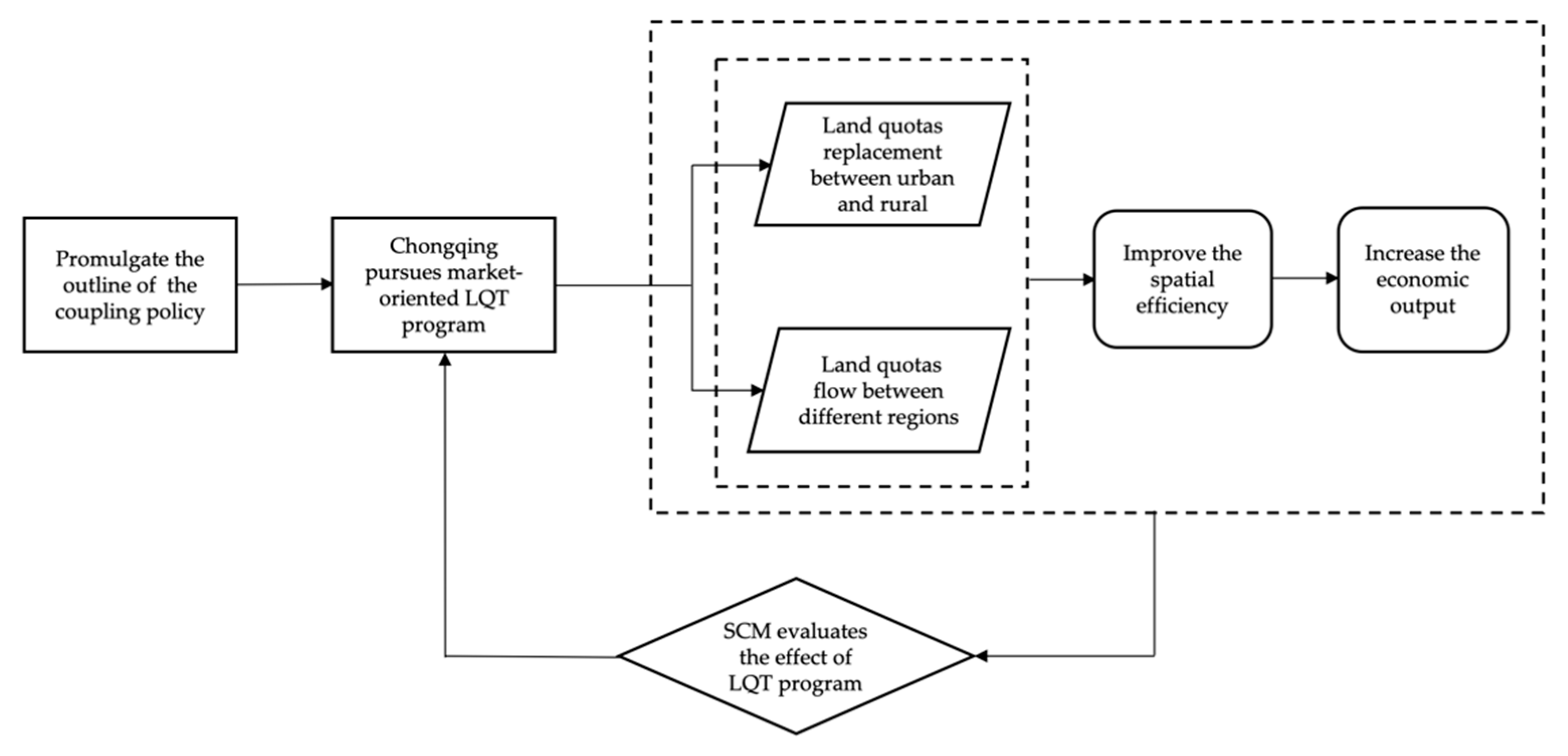

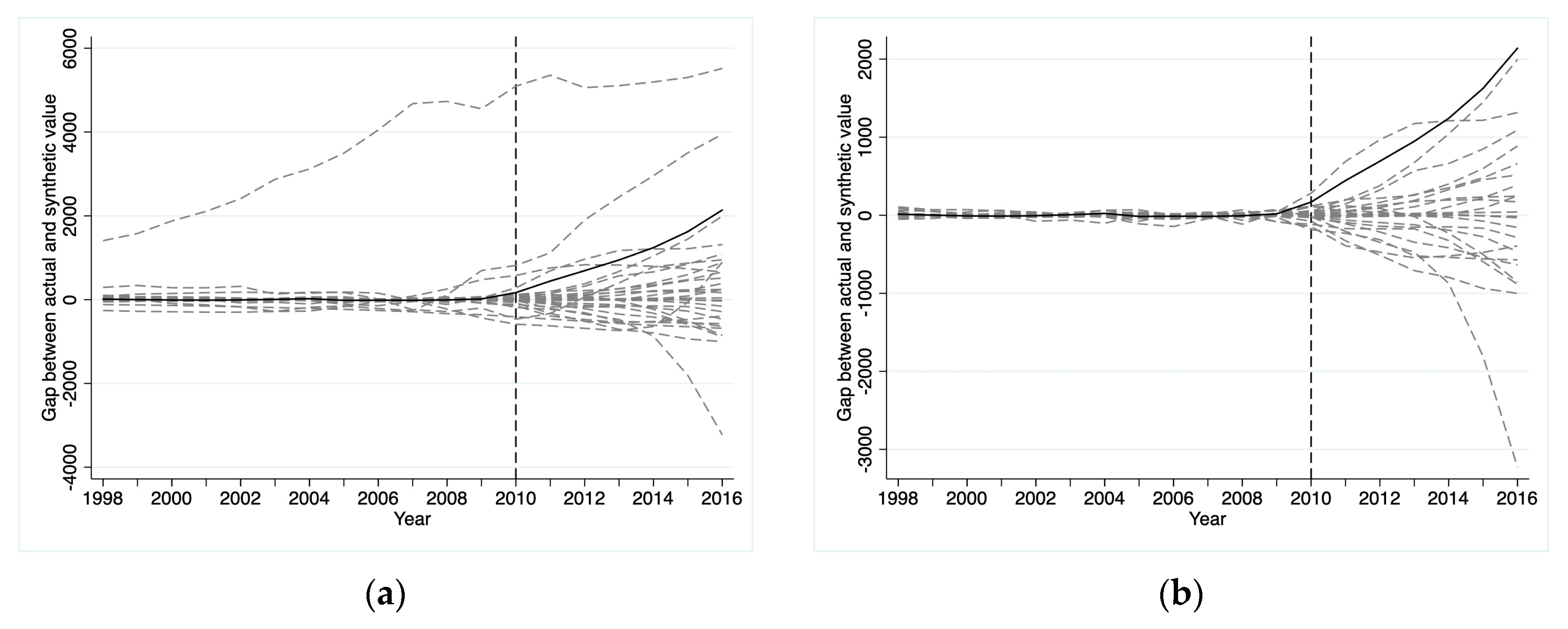
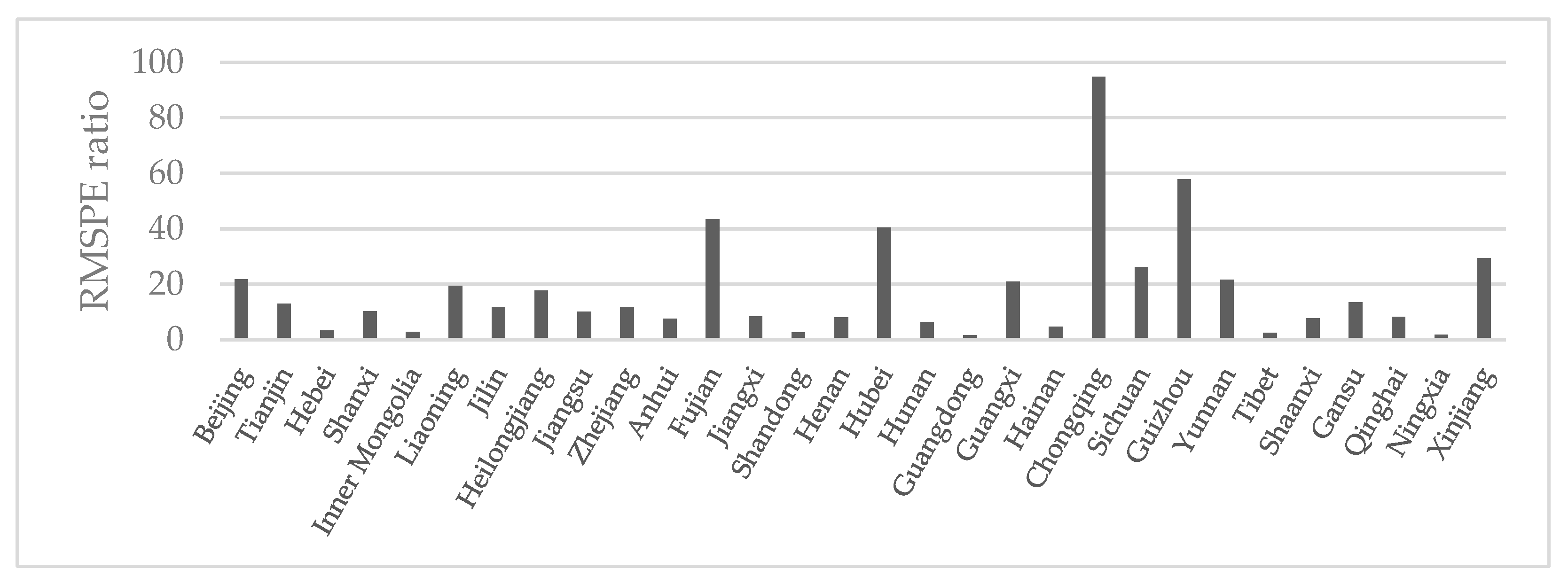
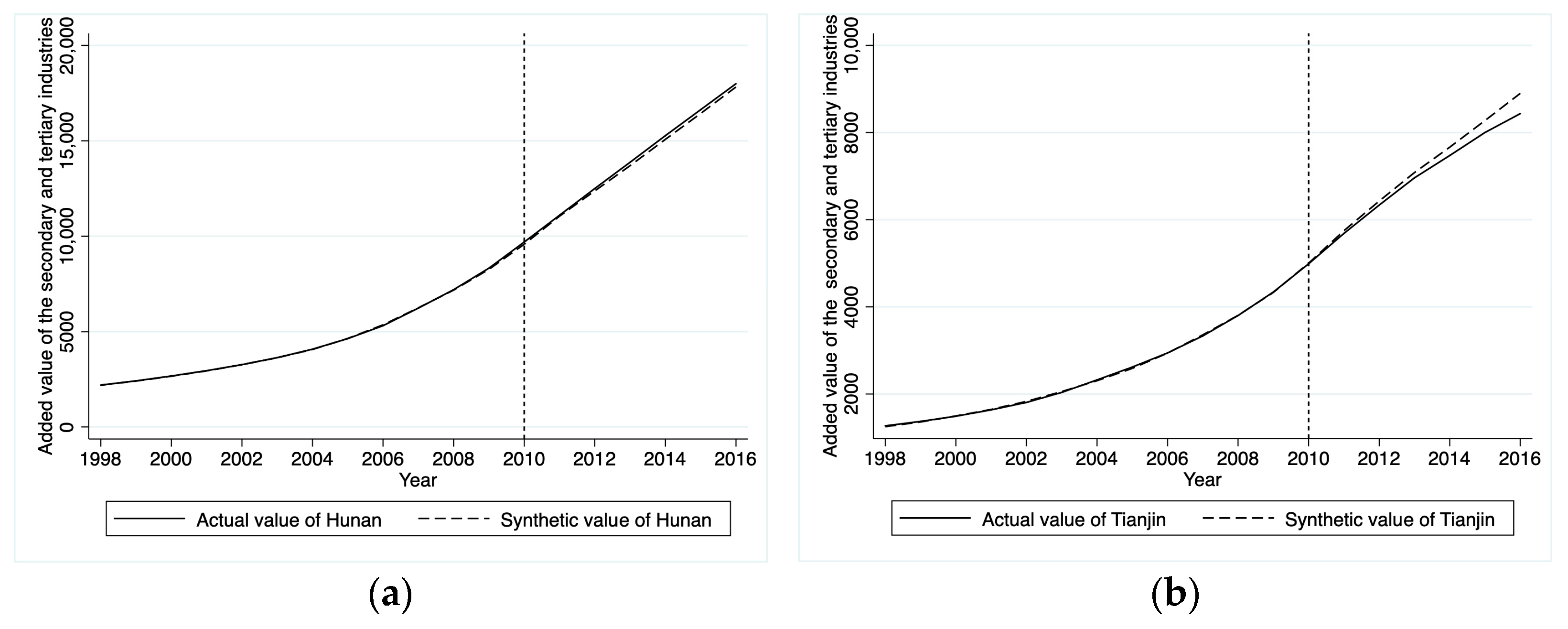
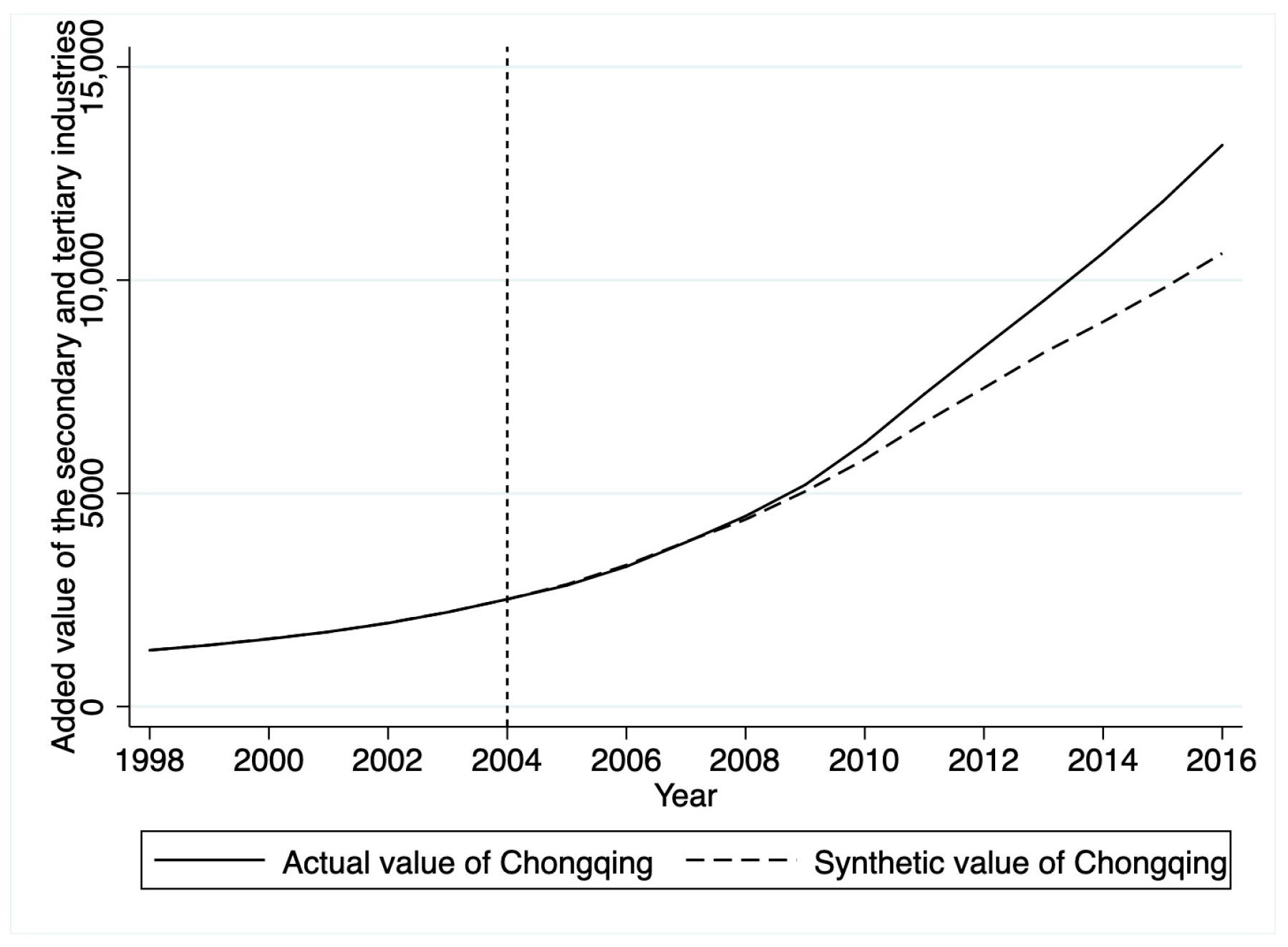
| Province | Hunan | Tibet | Inner Mongolia | Tianjin | Jiangxi |
|---|---|---|---|---|---|
| Weight | 0.459 | 0.28 | 0.143 | 0.089 | 0.029 |
| Variables | Meaning (Unit) | Chongqing | Average Value of Others | |
|---|---|---|---|---|
| Actual Value | Synthetic Value | |||
| Capital input | Fixed capital stock of secondary and tertiary industries (billion yuan) | 3136.857 | 3191.654 | 6839.570 |
| Labor input | Employees of secondary and tertiary industries (thousand) | 7777.183 | 100,053.160 | 14,213.171 |
| Land input | Construction land area in last year (km2) | 466.818 | 603.765 | 1134.244 |
| Added construction land area (km2) | 41.732 | 28.879 | 57.884 | |
| Economic development | Number of units of industrial enterprises above designated size | 3133.500 | 4567.306 | 9819.866 |
| Per capita GDP (yuan/person) | 11,730.750 | 11,454.600 | 23,753.490 | |
| Variables | (1) Total | (2) Western | (3) Central and Northeastern | (4) Eastern |
|---|---|---|---|---|
| DID | −322.993 (0.425) | 316.727 (0.653) | −206.5422 (0.472) | −874.088 (0.219) |
| Controlled variable | Yes | Yes | Yes | Yes |
| Regional fixed effect | Yes | Yes | Yes | Yes |
| Time fixed effect | Yes | Yes | Yes | Yes |
| Sample number | 547 | 205 | 171 | 171 |
| R2 | 0.986 | 0.977 | 0.990 | 0.991 |
Publisher’s Note: MDPI stays neutral with regard to jurisdictional claims in published maps and institutional affiliations. |
© 2022 by the authors. Licensee MDPI, Basel, Switzerland. This article is an open access article distributed under the terms and conditions of the Creative Commons Attribution (CC BY) license (https://creativecommons.org/licenses/by/4.0/).
Share and Cite
Liu, X.; Zhang, X.; Wang, M.; Guo, Z. Is Urban and Rural Construction Land Quota Trading “Chicken Ribs”? An Empirical Study on Chongqing, China. Land 2022, 11, 1977. https://doi.org/10.3390/land11111977
Liu X, Zhang X, Wang M, Guo Z. Is Urban and Rural Construction Land Quota Trading “Chicken Ribs”? An Empirical Study on Chongqing, China. Land. 2022; 11(11):1977. https://doi.org/10.3390/land11111977
Chicago/Turabian StyleLiu, Xiaojing, Xiao Zhang, Mingsheng Wang, and Zhongxing Guo. 2022. "Is Urban and Rural Construction Land Quota Trading “Chicken Ribs”? An Empirical Study on Chongqing, China" Land 11, no. 11: 1977. https://doi.org/10.3390/land11111977
APA StyleLiu, X., Zhang, X., Wang, M., & Guo, Z. (2022). Is Urban and Rural Construction Land Quota Trading “Chicken Ribs”? An Empirical Study on Chongqing, China. Land, 11(11), 1977. https://doi.org/10.3390/land11111977




